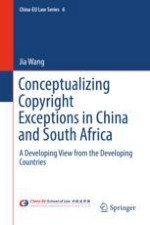2018 | OriginalPaper | Chapter
4. The Technological Revolution and Its Impact on Copyright Law
Author : Jia Wang
Published in: Conceptualizing Copyright Exceptions in China and South Africa
Publisher: Springer International Publishing
Activate our intelligent search to find suitable subject content or patents.
Select sections of text to find matching patents with Artificial Intelligence. powered by
Select sections of text to find additional relevant content using AI-assisted search. powered by
